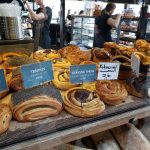 Eleven food-loving tourists from the US and England gathered on a sunny Saturday morning for a walk through the Denmark food scene. Our five hour Copenhagen Culinary Experience was an introduction to the exciting flavors that are available these days in this bustling city.
Eleven food-loving tourists from the US and England gathered on a sunny Saturday morning for a walk through the Denmark food scene. Our five hour Copenhagen Culinary Experience was an introduction to the exciting flavors that are available these days in this bustling city.
“After the war, Danish food was mostly about keeping the cost down and eating simple food — the same things, all mashed up, day after day,” explained Katherine, our enthusiastic tour guide. As the group started our exploration, she assured us that things had improved.
About fifteen years ago Chef Rene Redzepi founder of the world-famous Noma restaurant in Copenhagen changed all that. He and his fellow chefs wrote a manifesto for a new Danish cuisine that demanded innovative cooking with local, fresh, high-quality ingredients. His ideas caught on and now Copenhagen, as the tour demonstrated, is a food destination.
The year-round indoor market at Torvehallerne is one of the most popular results of Redzepi’s movement. On the bright afternoon in September when we visited, throngs of Danes (and some tourists too) cruised the aisles stocking up on provisions, stopping for coffee, snagging a sweet, and getting an ice cream cone to enjoy in the mild weather.
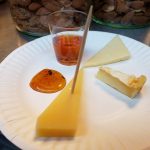 The Danes drink coffee all day long, constantly indulge their national sweet tooth, and love to eat. Generally slim and fit, they prefer walking and have a national obsession with bike riding that keeps their waistlines under control. On our tour, we walked over five hours from taste to taste, building our appetite and working off the calories.
The Danes drink coffee all day long, constantly indulge their national sweet tooth, and love to eat. Generally slim and fit, they prefer walking and have a national obsession with bike riding that keeps their waistlines under control. On our tour, we walked over five hours from taste to taste, building our appetite and working off the calories.
The Culinary Experience began with three cheeses. You’ve heard of Danish blue, I’m sure, but Redzepi and his pals encouraged Danish dairymen to experiment with distinctive, small-batch cow’s milk cheeses. The exceptional new cheeses we tasted included Seamist, aged one year; Old Crunch, aged two years; and Forgotten, a bloomy rind cheese aged in parchment.
Denmark is an archipelago with about 70 inhabited islands. You can easily drive from Copenhagen to close-by Sweden across the 7.5 mile Øresund bridge/tunnel. The Danish island of Bornholm, however, is an overnight easterly ferry ride out into the Baltic. Bornholm’s milder climate supports some crops that will not thrive in the rest of Denmark. At Torvehallerne we tasted sweet-tart sea buckthorn berry jam, rich in vitamin C. Small producers on Bornholm also make artisanal licorice (a national passion), mustard, crackers, and old fashioned caramel candies. All these products feed the hunger for high-quality Danish-made foods.
During a stroll through the verdant Copenhagen Botanical Garden Katherine described local efforts to restore bee habitat and increase honey production. She gave us a taste of two local honeys — strikingly different flavors from urban and rural environments.
From the garden we walked between lakes, once defences of the city, to lunch at Aamann’s Deli and Takeaway for a modern take on the traditional Smørrebrød. (Smørrebrød, not to be confused with the Swedish Smörgåsbord, means buttered bread in Danish).
Adam Aamann, part of the Redzepi revolution, updated the Danish classic with organic and local ingredients, creative presentations, and seasonal supplies. We oohed and aahed over our four artfully  arranged Smørrebrød: potato slices dabbed with smoked mayonnaise; organic hard-boiled eggs under a tangle of fresh dill; smoked salmon with horseradish and sprouts; and chicken salad with curly lettuce and crumbled crisp-fried chicken skin — all on generously buttered organic rye bread. What a feast!
arranged Smørrebrød: potato slices dabbed with smoked mayonnaise; organic hard-boiled eggs under a tangle of fresh dill; smoked salmon with horseradish and sprouts; and chicken salad with curly lettuce and crumbled crisp-fried chicken skin — all on generously buttered organic rye bread. What a feast!
Next stop? A brewery of course! The Danes love beer. Nørrebro Bryghus, much like our local Two Roads Brewing, looks to brew excellent examples of traditional beers and adventurous new styles as well. To the delight of the beer lovers in the group, we sampled a crisp and light weissbier, a brown ale that was a mouthful of rich malt, and a tart, hoppy three-year barrel aged sour beer that was a little like lemonade for grownups.
 The increasingly jovial group walked off our beer with a trek to the narrow cobbled streets of the old town. Under the shadow of the 17th-century round tower built by Christian IV, we stopped at a kiosk for Danish hot dogs, a surprising national favorite. The traditional pork sausage in a bun is topped with fried and raw onion plus homemade pickles. Additional sausage choices include vegetarian, spicy beef, goat, or chicken. You should have seen the line to get these Danish dogs!
The increasingly jovial group walked off our beer with a trek to the narrow cobbled streets of the old town. Under the shadow of the 17th-century round tower built by Christian IV, we stopped at a kiosk for Danish hot dogs, a surprising national favorite. The traditional pork sausage in a bun is topped with fried and raw onion plus homemade pickles. Additional sausage choices include vegetarian, spicy beef, goat, or chicken. You should have seen the line to get these Danish dogs!
Our well fed and happy group walked back to the Torvehallerne market for a tour-ending dessert. The
Danes are crazy for flødeboller — marshmallow on a cookie drowned in chocolate. As a mass market confection they’ve been the mainstay of kids’ birthdays and the home treat cabinet for generations. At Summerbird, in the market, they’ve gone upscale with organic dark chocolate, handmade marshmallows, and marzipan cookies. Katherine told us that Danes consume an average of 42 flødeboller per person each year. That’s a lot.
For some Danish specialties closer to home, visit the Scandinavian Butik at 349 Main Avenue in Norwalk. There you can find some of the typical Danish foods that we enjoyed. They serve authentic Smørrebrød at lunch Wednesday through Saturday until November.
After the tour Marsha and I needed to rest and reflect on the experience. Coffee from Laura’s Bakery in the market was just the thing. It seems like caffeine-fueled Copenhagen has a coffee shop on every corner and sometimes in the middle of the block too. Full as we were, a classic cinnamon swirl — a danish as we know it — flaky, buttery, and well-cinnamoned was irresistible.
 Fortified with butter, sugar, and caffeine, Marsha and I walked the rest of the market. A long line in front of the ice cream stand illustrated the Danish passion for frozen treats. Local seafood, hand-cut meats, fresh baked bread and lots of sweet treats were enticingly displayed alongside cheeses, cured meats, and impeccably fresh produce.
Fortified with butter, sugar, and caffeine, Marsha and I walked the rest of the market. A long line in front of the ice cream stand illustrated the Danish passion for frozen treats. Local seafood, hand-cut meats, fresh baked bread and lots of sweet treats were enticingly displayed alongside cheeses, cured meats, and impeccably fresh produce.
The Torvehallerne Market is dazzling and the Copenhagen restaurants we enjoyed are a cut above. Redzepi’s food revolution is unstoppable. From what we saw (and ate), he’s set Denmark on the right course.
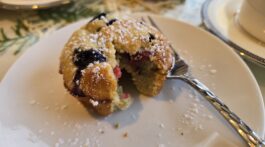









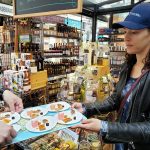



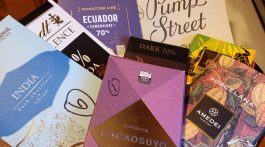
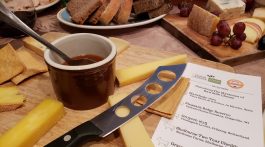

Thank you so much, this is so fun to read as a guide, to see what ressonated and what stood out to you as tourists 🙂 If you do come back, I will be happy to take you on another tour in our city 🙂 All the best!
Katrine